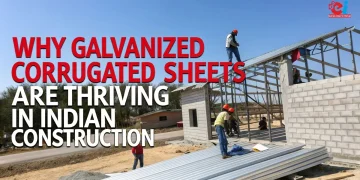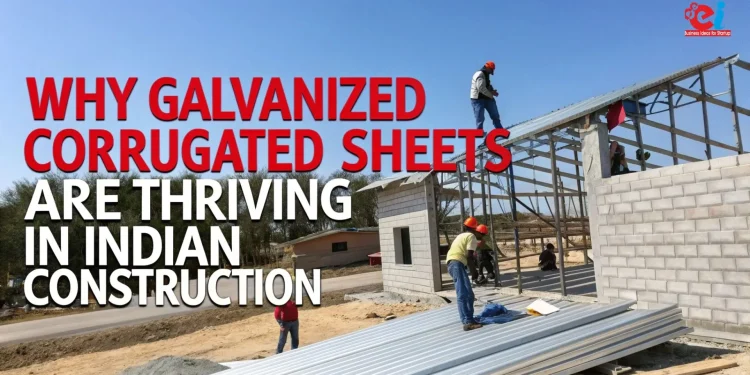With India and some other developing countries enhancing their infrastructure facilities and accelerating the pace of housing construction, the requirement for construction materials which are long lasting, flexible, and economical is at its peak. In the numerous products witnessing an increase in demand, corrugated galvanized sheet emerges as key building component. It combines the traditional use of materials and modern practices.
Corrugated Galvanized Sheets or commonly known as corrugated galvanized sheets has its roots back in the early 19th century. It still finds place in roofing, sidings, and even structural works. It is increasingly used for homes and rural infrastructure. Moreover, urban real estate along with smart cities also use it extensively. The distinctive wave-like patterns engraved on sheds and warehouses makes it appealing to the eyes. It is made of zinc coated steel which makes it economically and functionally resilient.
In this article, we analyze the framework market demand for galvanized corrugated sheeting focusing on growth drivers, sector-wise application patterns, regional trends, and potential in the eyes of manufacturers, distributors, and developers of infrastructure.
Corrugated Galvanized Sheets: Efficient Construction Solutions
CGS or Corrugated Galvanized Sheets are manufactured from steel which has already been Zinc coated. In a factory setting, the steel will then be put through a cold rolling process in which the steel is shaped into wavy ridges. Zinc protects metal from rusting and corrugation helps to increase the strength to weight ratio and makes Corrugated Galvanized Sheets suitable for roofs, external walls, fences and temporary shelters.
CGS is unique because of its versatility according to climate. In costal areas where humidity is high, the salt in air can corrode ungalvanized metal, so galvanization saves the metal. Hill and snow prone areas benefit from the corrugation because of snow and water being shed easily. In dry areas the region’s high temperatures can contribute to melting ice and snow helping to reduce structural load. CGS also acts as a thermal regulator because of its shiny surface.
CGS’s market performance in comparison to other products is unmatched, giving reason to builders to prefer other Corrugated Galvanized Sheets. With proven performance from the cost conscious builders along with infrastructure developers helps gaps in the market.
Related: Rise in the Industry of Corrugated Galvanized Sheet
Urban Demand and Real Estate Applications
Demand in cities for new Commercial and Residential buildings along with real estate is increasing.
India is undergoing swift urbanization, with a forecasted urban population of over 500 million by 2035. Due to this, there is a need for strong yet affordable construction materials which galvanised steel is able to provide. In the commercial sector, CGS is widely utilized for industrial roofing, warehouse walls, and storage facilities. Its low maintenance, quick installation, and structural integrity make it preferred in factory sheds and logistic parks. Real estate developers utilize CGS for site offices, boundary walls, low height auxiliary structures, partition walls, and temporary walls.
In urban areas, especially in low-income settlements, horizontal informal housing clusters rely on CGS for quick-build side walls and roofs. Rustic and industrial aesthetics of CGS add value for its incorporation in garages, service areas, rooftop enclosures, and even in premium housing projects farmhouses.
CGS’s recurring bulk demand from sheet manufacturers is created by infrastructure urban projects like metro rail construction, road overbridges, and commercial complexes that use CGS for safety barricades, temporary sheds, hoardings, and commercial grade CGS.
Rural and Agricultural Applications: Affordability Meets Utility
CGS is the epitome of economical solutions in the rural regions. It is renowned for roofing in village schools, cattle shelters, and poultry farms. Farmhouses and grain storage sheds utilize it for cost-effective constructions. Its practicality in the agricultural sector stems from its resistance to wind, fire, rainfall, and pests.
The government subsidizes rural housing schemes as in Pradhan Mantri Awas Yojana (Gramin) which recommends galvanized sheets as part of the material palette due to their easy installation and low cost. Lightweight CGS is favored for reconstruction efforts post floods, cyclones, or earthquakes because of its easy transportation.
Electrification and expansion of remote telecoms generate more demand for CGS in the enclosed transformer shelters and relay stations. The combination of construction and infrastructural requirements from rural India fuels the growth for the sector.
Public Sector and Infrastructure Undertakings: Main Demand Focus Areas
India’s ongoing infrastructure investment with over 111 lakh crore under the National Infrastructure Pipeline (NIP) increased the market for construction materials such as CGS with further spending. Corrugated galvanized sheets are needed in growing volumes in smart cities and airports as industrial corridors and highways make use of it in infrastructure projects.
CGS is used for the fences and roofs of water treatment facilities, construction zone border temporary enclosures, and transit sheds and railway platform cabins. Also, wide ranges of internally supplied PSUs backup warehouses and auxiliary structures to energy plants use these materials on a large scale.
Another important consumer includes the military for defense operations, aid activities, and the Indian Army. CGS and the Border Roads organization have uses in building temporary shelters, storehouses, and relief shelters in disaster management locations, high altitudes, and remote areas where traditional building materials are not practical.
Domestic production of galvanized sheets had massively surged due to the government’s “make in India” and “Aatmanirbhar Bharat” initiatives. This resulted in the better control of project timelines and expenditure alongside strengthening the public infrastructure supply chain.
Reinforcing Long-Term Market Trust
There has been a noticeable increase in the use of corrugated galvanized sheets for a variety of functional, economic, and logistical reasons.
- Durability – Claims CGS construction experts last between 20-30 years with little maintenance due to a protective zinc coating CGS acts as a sacrificial barrier.
- Light weight – Allows for effortless transportation and installation, especially to areas which are remote and difficult to access.
- Thermal reflectivity – Reduces energ riad get boxed in forgiet the steem geed Amer gogo black adghab wgeta ur Alter the cruise in hot climates while helping sustain lower cooler interiors.
- Fire resistance – Offers protection from combustion making it suitable for indudstrial and rural features.
- Cost-effectiveness – Significantly cheaper over its life cycle than many conventional building materials.
Such features guarantee the use of CGS materials in projects that need to be economically friendly and completed quickly while also being sturdy.
Related: Strategic Entry into Galvanized Steel Structures for Solar Projects
Emerging Trends and Market Innovation
The market continues to innovate in PVDF-coated profiles and color-coated galvanized sheets, in addition to CGS corrugated with integrated insulation. These innovations provide better aesthetics, energy efficiency, and durability.
Projects under Green Building certifications as well as LEED certified buildings are increasing the demand for materials that are recyclable and eco-friendly. Environmentally responsible builders are adopting galvanized sheets manufactured using recycled steel, low emission paints, and coatings.
BIM along with other digital tools such as prefabrication planning are encouraging manufacturers to make their product libraries CAD-ready and standardized to sizing which increases their adoption within large scale constructions.
Challenges and the Road Ahead
While demand for CGS is high, the market experiences price instability with zinc and steel, limiting price competition. Margins are heavily impacted. Quality inconsistencies from smaller manufacturers erode trust, making standardization and certification necessary within the industry.
In some areas, dependence on imports for high-grade galvanized steel creates delays. There is a need to strengthen distribution networks in rural and northeastern areas to ensure consistent supply.
Moreover, as the construction industry becomes more sophisticated and value-oriented, the market for branded, boxed, and customizable corrugated galvanized sheet products is emerging. The emerging demand will be captured best by the manufacturers who put their resources in technology, quality assurance, and all-India logistics.
Conclusion: The Corrugated Galvanized Sheet – An Unshakable Pillar of India’s Growth Story
CGS proves its relevance from low-priced rural housing to multi-million dollar infrastructure projects as a ready, timeless, and adaptable construction material. Its strategic value is drawn from the fact that it fulfills econimic and technical requirements, but not without trade-offs.
CGS will continue to play a foundational role in supporting India’s architectural and infrastructural feats as the country advances in modernization, urbanization, and industrialization. Its value lies not just in serving as a product, but in providing long-term growth opportunities for manufacturers, traders, and infrastructure developers. And these opportunities are rooted in durability, dependability, and immense market demand.
Niir Project Consultancy Services (NPCS) provides detailed project reports, technical guidance, feasibility studies, and investment consultancy for sheet metal and galvanized steel product businesses across India and abroad.


























